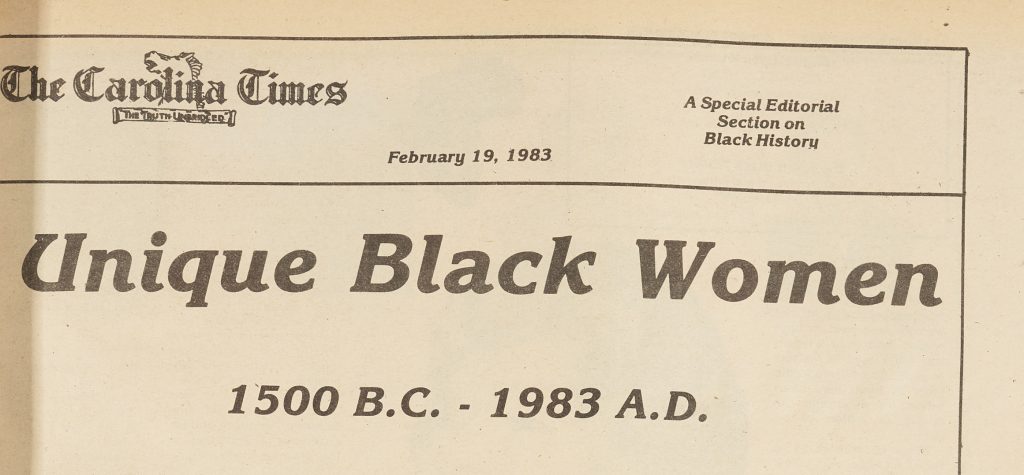
Digital NC has new issues of The Carolina Times thanks to our partner, the University of North Carolina at Chapel Hill. Included among the new issues is a special editorial to highlight “unique Black women.” The Carolina Times demonstrated a commitment to celebrating Black history through its frequent educational articles.
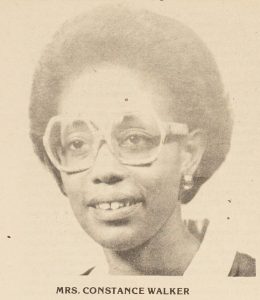 The “Unique Black Women” feature covers recognizable names, including journalist Ida B. Wells (1862-1931), activist Rosa Parks (1913-2005), and politician Shirley Chisholm (1924-2005). The editorial also celebrates local Durham heroes, such as West End neighborhood elder and activist Constance Walker (1942-).
The “Unique Black Women” feature covers recognizable names, including journalist Ida B. Wells (1862-1931), activist Rosa Parks (1913-2005), and politician Shirley Chisholm (1924-2005). The editorial also celebrates local Durham heroes, such as West End neighborhood elder and activist Constance Walker (1942-).
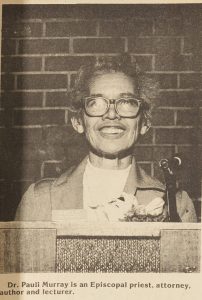
The editorial includes the Rev. Dr. Pauli Murray (1910-1985), a priest, scholar, lawyer, and poet who grew up in Durham, North Carolina. Dr. Murray was the first Black person to earn a Doctor of the Science of Law degree from Yale. Murray’s legal arguments were utilized to end public school segregation and advance women’s rights in the workplace.
While Dr. Murray’s impact extends around the world, their legacy is especially honored in Durham. Murray attended Hillside, a historically Black and segregated high school. They later wrote Proud Shoes: The Story of an American Family about their family and the history and legacy of segregation in Durham. Today, there are now murals across the city with Murray’s image. Work like this 1983 article helps preserve Durham’s memory and honor its local leaders, making future initiatives possible.
You can see all available issues of The Carolina Times here or browse our North Carolina Newspaper collection by location, type, and date. For more information about UNC Chapel Hill and its library holdings, you can visit its partner page or its website.

You may be surprised to learn what was worrying the citizens of Chapel Hill and Carrboro in 1958. Our most recent additions from the Chapel Hill News Leader, supplied by our partner, the Chapel Hill Historical Society, touch on everything from the University of North Carolina at Chapel Hill, civil rights, alcohol laws, and policing to some new technologies arriving the city.
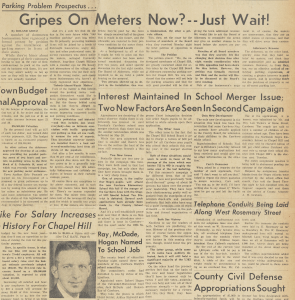
July 31, 1958
One of the first big stories breaks about midway through the year: the parking meter debacle. Apparently, the Chapel Hill Board of Aldermen had been tossing around the idea of installing parking meters for a couple of years, and the decision to finally do it happened in 1958. Local businessmen immediately pushed back, arguing that instituting paid parking would hurt their businesses.
Apparently, everyone could agree on the fact that the parking meters were ugly, but the author of the article, Roland Giduz, speculated that complaints about the meters would die down once everyone realized how much they improve traffic (spoiler alert: that doesn’t really happen based on the coverage that follows).
Just below the meter gripes article is another big story of the year: school integration. It describes two issues for an upcoming school merger election: first, whether Black students would attend Carrboro Elementary School, and second, whether the Chapel Hill School Board would charge $30 tuition for students from Carrboro. (Note: more materials about Carrboro Elementary School were also uploaded in this batch, including architectural plans and a document of education specifications).
The earlier articles that this one refers to (from May 22, 1958) don’t mention race until the very last line: “As to the general pupil assignment policy for next year, [Mr. Culbreth] said that he anticipated that the Board would re-adopt the existing regulations, whereby racial segregation has been maintained.” As the July article notes, this is four years after the Brown v. Board Supreme Court decision declaring racial segregation in public schools unconstitutional.
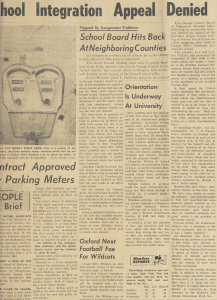
September 11, 1958
The issue gets a more personal focus in the September 11, 1958 issue, when the Orange County School Board denied Lee and Lattice Vickers’ child admittance to the then all-white Carrboro Elementary School. The Vickers’ case was set against the backdrop of ongoing school assignment problems, with neighboring school systems fighting each other over pupil placement and resources.
The fight to racially integrate schools in Chapel Hill (and throughout North Carolina) continued well into the 1960s, and, sadly, none of the community papers that we have from the area extend past 1963. One of the latest articles available, from The Chapel Hill Weekly, reports a survey of Southern business leaders and how their perspective on industry shaped their views on the matter.
But, in 1958, public school integration was still competing for front page space with—you guessed it—parking meters.
Another major debate in the community during this time was over the sale of alcohol. North Carolina was ahead of the curve of prohibition, outlawing the sale and manufacture of alcohol in 1909 (a decade before the national amendment). And, even after the repeal of prohibition in 1933, the Alcoholic Beverage Control system wasn’t created until 1937. (Graham County remained a “dry” county until just recently). In 1958, there was still a lot of resistance to the ABC setting up shop.

November 17, 1958
In this case, efforts were headed by a citizens group concerned about the effects of the ABC stores in the area. Meetings were held at the University Baptist Church, though Carolyn Noell, a spokesperson for the group, noted that local churches were only providing contacts and spaces (not serving as official sponsors).
Not long before this, the News Leader reprinted an article from the Durham Morning Herald about how lucrative the ABC stores were. Apparently, the Durham ABC stores sold almost $58 million of alcohol from June 30, 1957, to September 1958 (enough to pay for Durham’s entire share of the Raleigh-Durham airport, plus some for Lincoln Hospital, local schools, warehouse equipment, public libraries, garbage disposal services, and a rabies inspection program, among other things). To put these sales into proportion, a fifth of whiskey (from a “popular brand”) cost $3.95 back then. Certainly, money was at the heart of the argument for the Orange County Citizens for Legal Control in their ad in the January 29, 1959 issue.
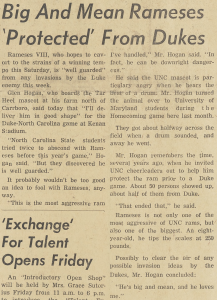 Of course, in a college town like Chapel Hill, there’s also frequent news about the University. One article, from October 2, 1958, warned that student enrollment may swell to between 12,000 and 14,000 in 1970 (today, total enrollment exceeds 30,000). And—surprise!—much of the concern about the growing student population is related to parking.
Of course, in a college town like Chapel Hill, there’s also frequent news about the University. One article, from October 2, 1958, warned that student enrollment may swell to between 12,000 and 14,000 in 1970 (today, total enrollment exceeds 30,000). And—surprise!—much of the concern about the growing student population is related to parking.
One of the funnier articles about UNC-CH is about Rameses, the live mascot (not to be confused with costumed cheerleader Rameses, former bodybuilder). Rameses VIII, then in power, was “the most aggressive ram I’ve handled,” according to Glen Hogan, his boarder. He was also one of the biggest up until then, clocking in at 250 pounds. These two facts, Hogan hoped, would dissuade rival Duke students from stealing the mascot.
The reigning Rameses (né Otis) ascended in 2020 as the twenty-second mascot. His handler, James Hogan, is part of the same family that has been caring for the mascots since the 1920s. Rameses XXII has “come a long way” in getting used to people and is (presumably) a bit sweeter than his “big and mean” predecessor—though he is still well-guarded.
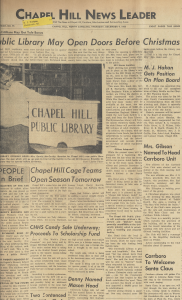
December 4, 1958
One final story from 1958 is the opening of the Chapel Hill Public Library, which was originally opened in the Hill House on West Franklin Street. The goal, according to Mrs. Richmond Bond, chairman of the board, was to “supplement” the University’s library by focusing on children’s and popular books that were generally unavailable at UNC.
Bond argued that Chapel Hill was the only town of its size in North Carolina without a public library and that the University library had “almost more than it can do” with the increase of UNC students. This led the Board of Aldermen to approve a $4,600 grant for the local library. Somebody even donated over 300 books before the library opened its doors.
In the very last uploaded issue of the Chapel Hill News Leader, from January 29, 1959, the top headline reads, “Death of a Newspaper.” Due to internal litigation, the paper had to stop running.
You can see all of our issues of the Chapel Hill News Leader here and more materials from the Chapel Hill Historical Society on their partner page. You can also visit their website for more information.
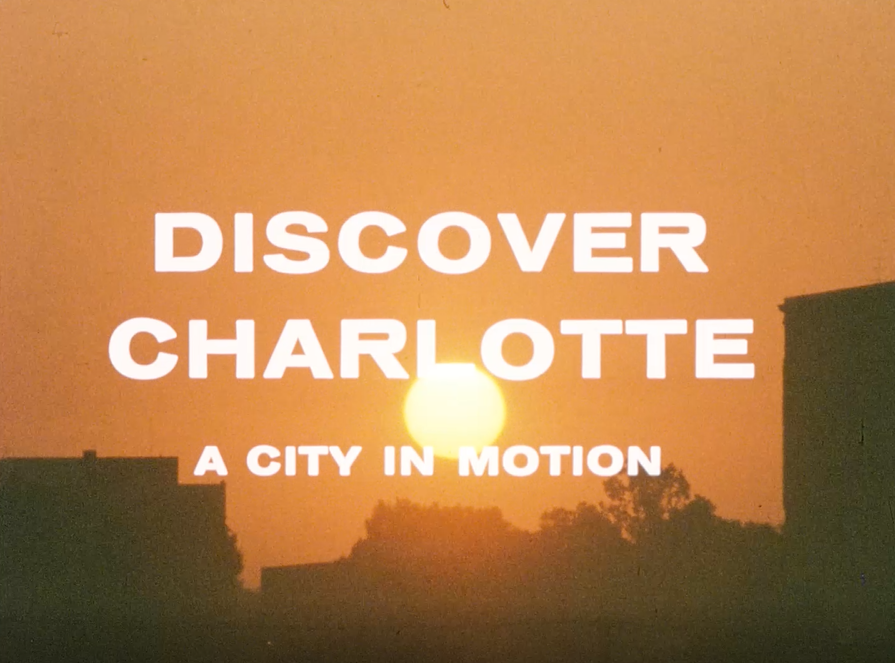
In partnership with the Charlotte Mecklenburg Library we’re pleased to share this 1968 film entitled Discover Charlotte – A City in Motion. Created by the Charlotte Chamber of Commerce and narrated by famous journalist and North Carolinian Charles Kurault, this promotional film boasts about Charlotte’s industrial and economic growth.
 In color with an upbeat soundtrack, Discover Charlotte lauds the motion of Charlotteans, beginning with a look at the city’s role in trucking, rail, and air transport. Turning to the banking industry, the film shows people processing large amounts of checks and cash and using adding machines at lightning speed. Shots of the Charlotte Record newspaper offices include coverage of Record employees learning via Teletype that Gene Payne, the Record’s cartoonist, had won a Pulitzer. You’ll see pilots and passengers at the Charlotte Douglas airport, Arthur “Guitar Boogie” and the Crackerjacks playing at the WBT station, computers whirring in a new data processing center, workers constructing a Duke power complex, and researchers examining newly woven textiles.
In color with an upbeat soundtrack, Discover Charlotte lauds the motion of Charlotteans, beginning with a look at the city’s role in trucking, rail, and air transport. Turning to the banking industry, the film shows people processing large amounts of checks and cash and using adding machines at lightning speed. Shots of the Charlotte Record newspaper offices include coverage of Record employees learning via Teletype that Gene Payne, the Record’s cartoonist, had won a Pulitzer. You’ll see pilots and passengers at the Charlotte Douglas airport, Arthur “Guitar Boogie” and the Crackerjacks playing at the WBT station, computers whirring in a new data processing center, workers constructing a Duke power complex, and researchers examining newly woven textiles.
Most of the film features scenes of middle and upper class white Charlotteans in work, social, or religious settings. In Charlotte, there is “a church for every man” and there are brief views of a number of religious institutions including Covenant Presbyterian Church, Dilworth Methodist Church, Holy Trinity Greek Orthodox Cathedral. Other events and activities shown in the film include
- Festival in the Park at Freedom Park,
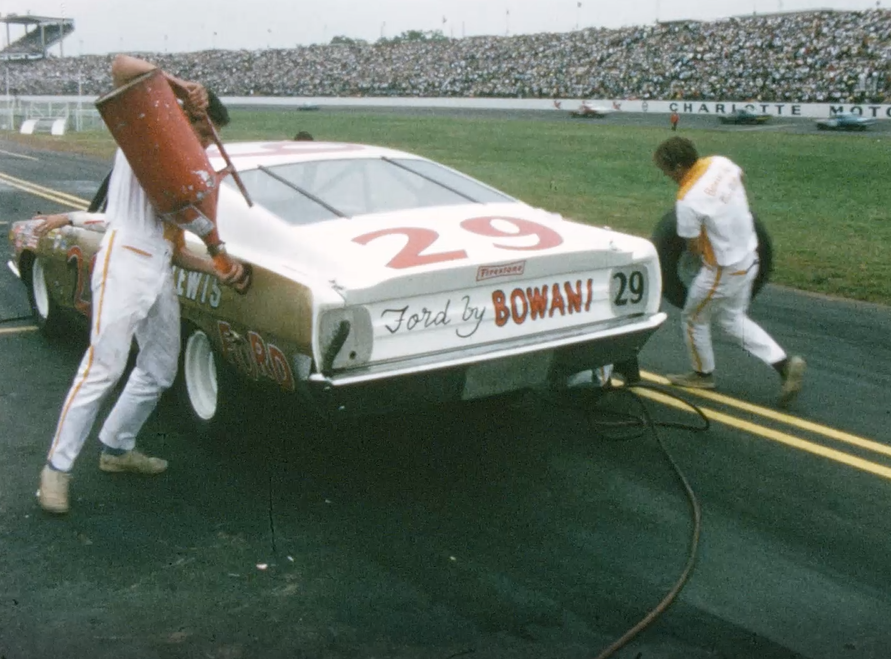
- the Mint Museum Drama Guild rehearsing a play,
- a wedding reception for an unnamed white couple,
- a Carolina v. NC State basketball game,
- a Charlotte Checkers hockey game, and
- a NASCAR stock car race.
There are also views of two university campuses, Johnson C. Smith and the relatively new UNC-Charlotte.
Filmed during the Civil Rights movement, there are only brief allusions to racial tensions. There is a snippet of white police officers talking about “riding with Negro officers,” which cuts to a group of black men and officers talking about a local march. The end of the film describes Charlotte’s participation in the Model Cities initiative and its “total attack on poverty,” efforts that were meant to eradicate urban blight that, as in many cities in America, ended up displacing and/or destroying minority-owned homes and businesses. The film ends with drawings of a planned expressway, widened streets, parks, new hotels and high rises.
This is one of a number of items Charlotte Mecklenburg Library has shared on DigitalNC. You can see more on their contributor page or learn more about their North Carolina collections on their website.
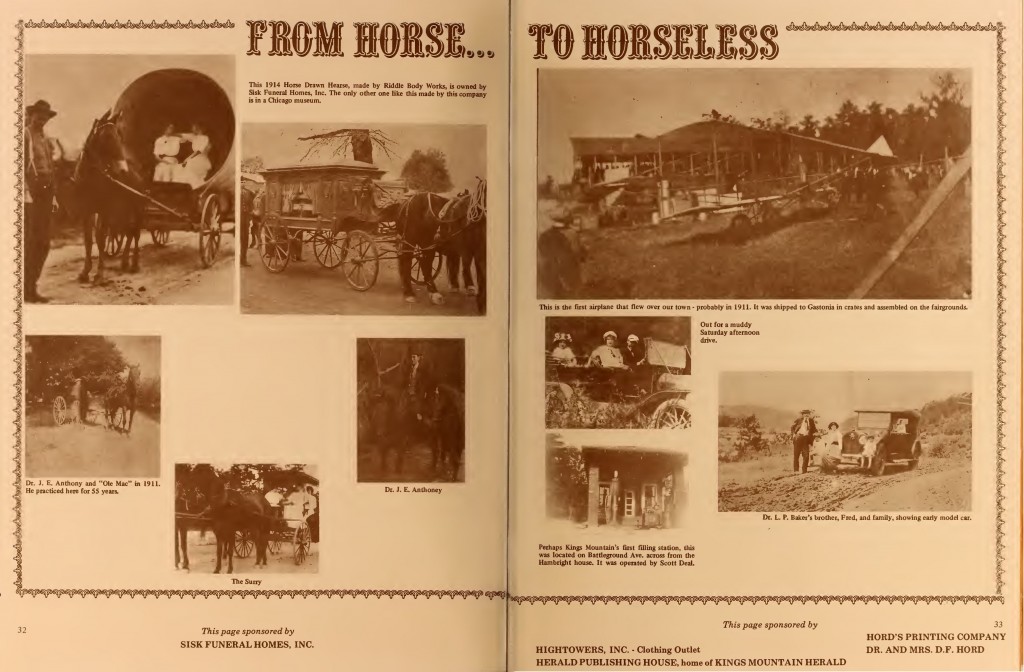
“From Horse to Horseless,” pages 32 and 33 in History and program commemorating the centennial of Kings Mountain 1874-1974.
Recently, we digitized the 1974 Centennial history and program for Kings Mountain, North Carolina, from new contributing institution Mauney Memorial Library. The booklet includes numerous photographs and a detailed history of the town, with each page sponsored by a different local business. Contents also include various programs for events relevant to the centennial celebration.
This addition to DigitalNC.org is just one of many digitized objects available online related to the celebration of a town or organization’s centennial celebration.
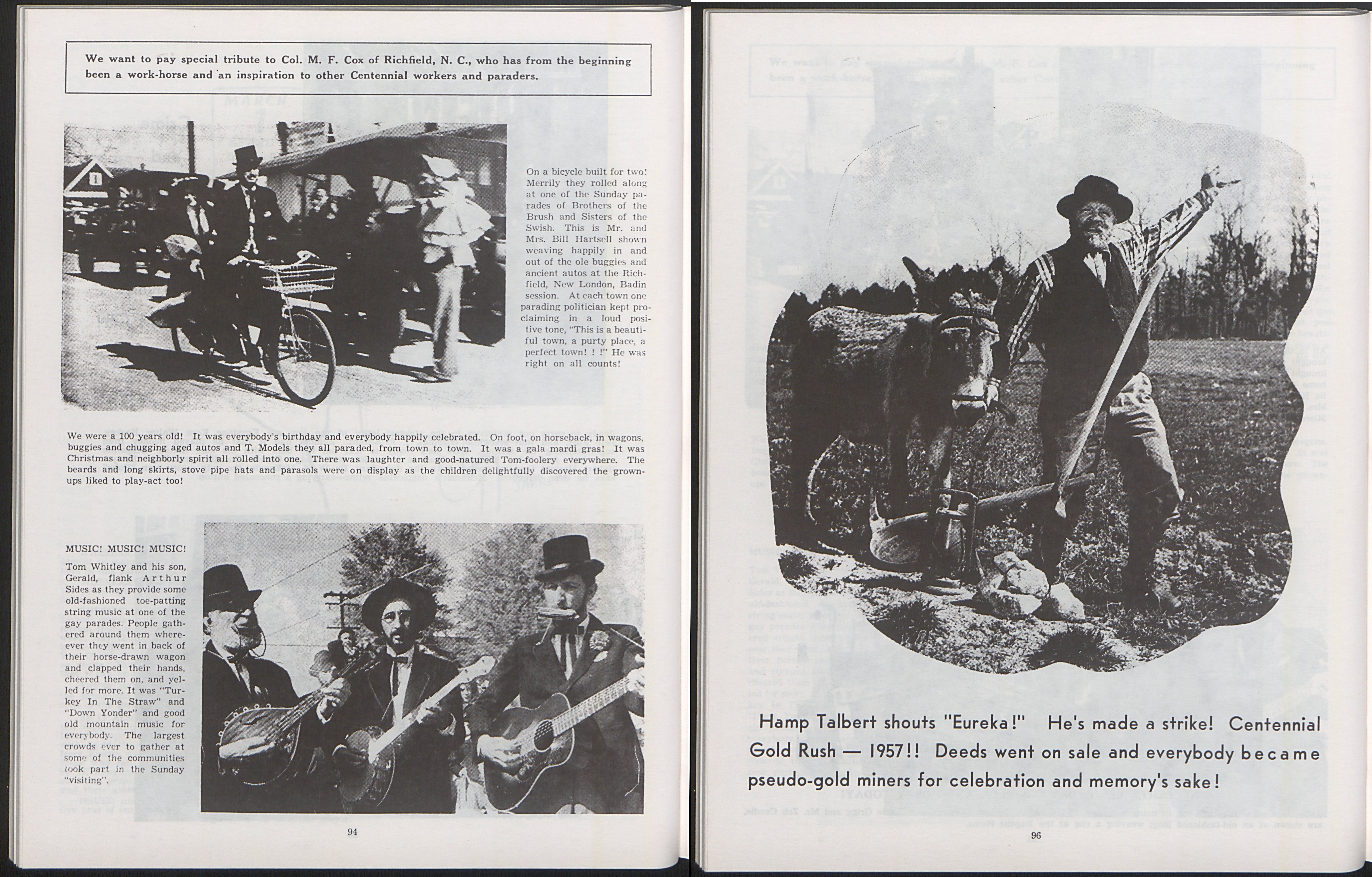
Page 94 and page 96 from the Albemarle, Stanly County Centennial.
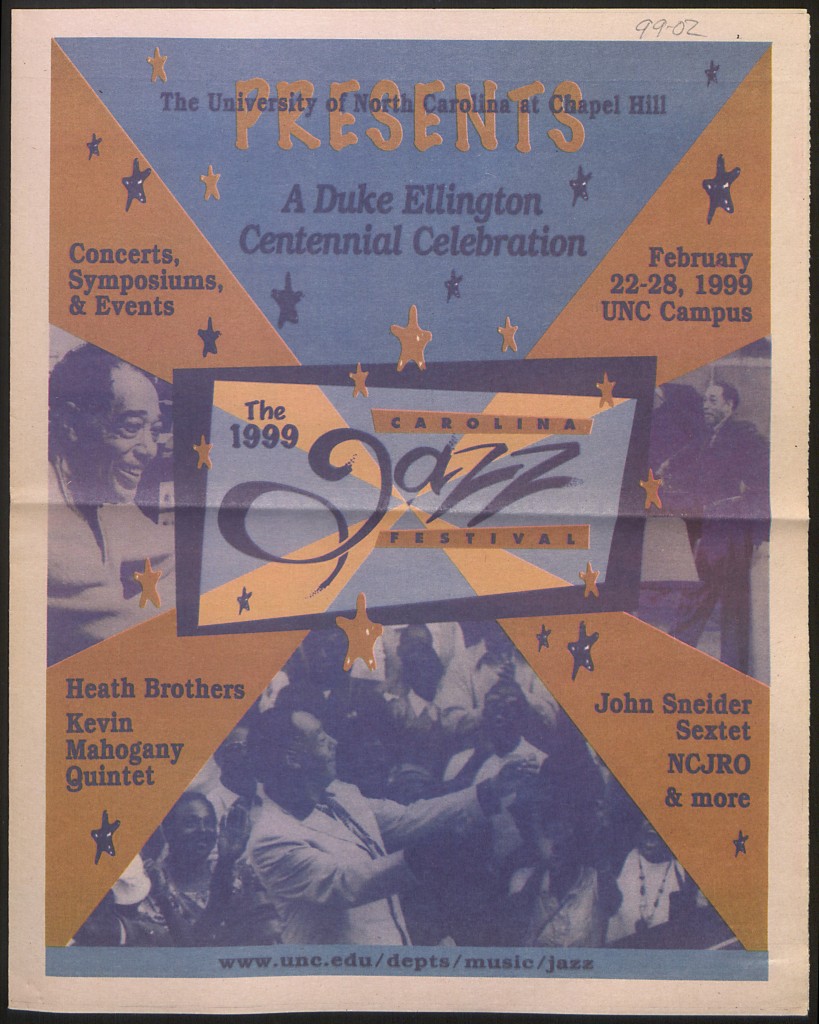
Front Cover of the Duke Ellington Centennial Celebration program
Among these materials is the Albemarle, Stanly County Centennial from 1957. The Bridge from Yesterday–Into Tomorrow is an Albemarle Centennial booklet published by the Albemarle-Stanly County Historic Preservation Commission. The booklet includes poetry, personal accounts from locals, and photographs of Albemarle citizens.
A more recent publication is A Duke Ellington Centennial Celebration from 1999. A Duke Ellington Centennial Celebration is a program generated by “Beyond Category: A Symposium on the Life, Works, and Orchestra of Duke Ellington,” a project made possible via the North Carolina Humanities Council. The symposium occurred on February 22-28, 1999, at the University of North Carolina at Chapel Hill. It included lectures on Jazz and many concerts performed by local and recognized musicians, including Kevin Mahogany and The Heath Brothers.
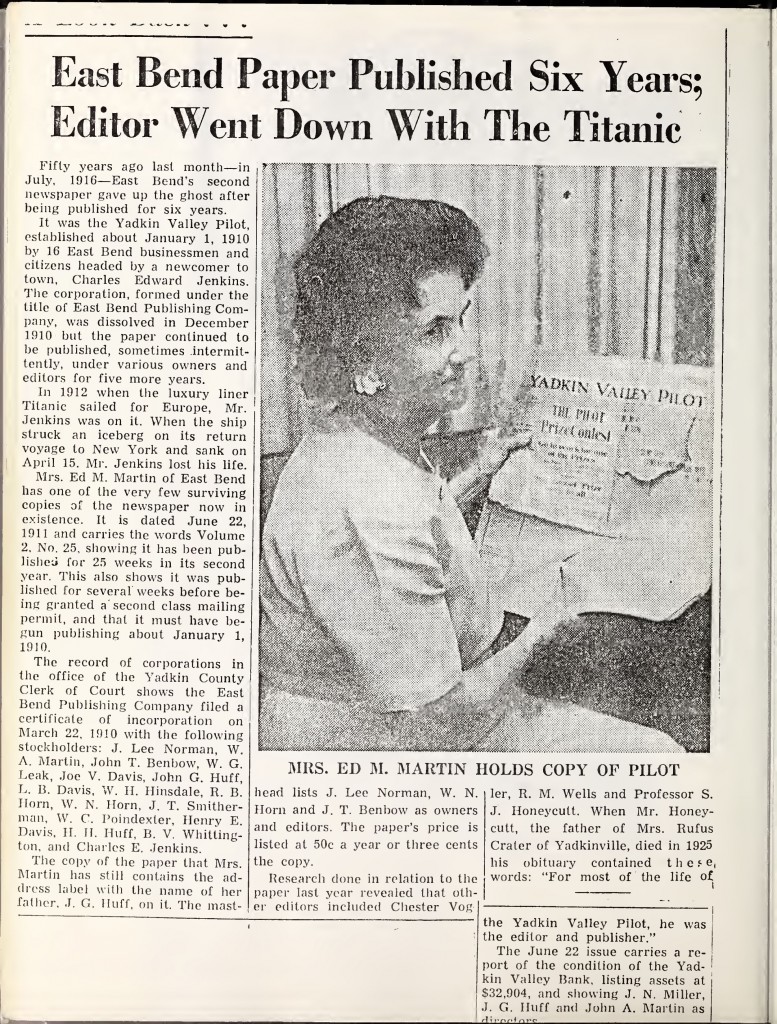
Page 50 of the East Bend Centennial Scrapbook
Another selection is the August 1987 East Bend Centennial Scrapbook, which commemorates the 100 year anniversary of the town of East Bend, which was founded March 7, 1887.
Click here to browse a selection of North Carolina Memory centennial materials.
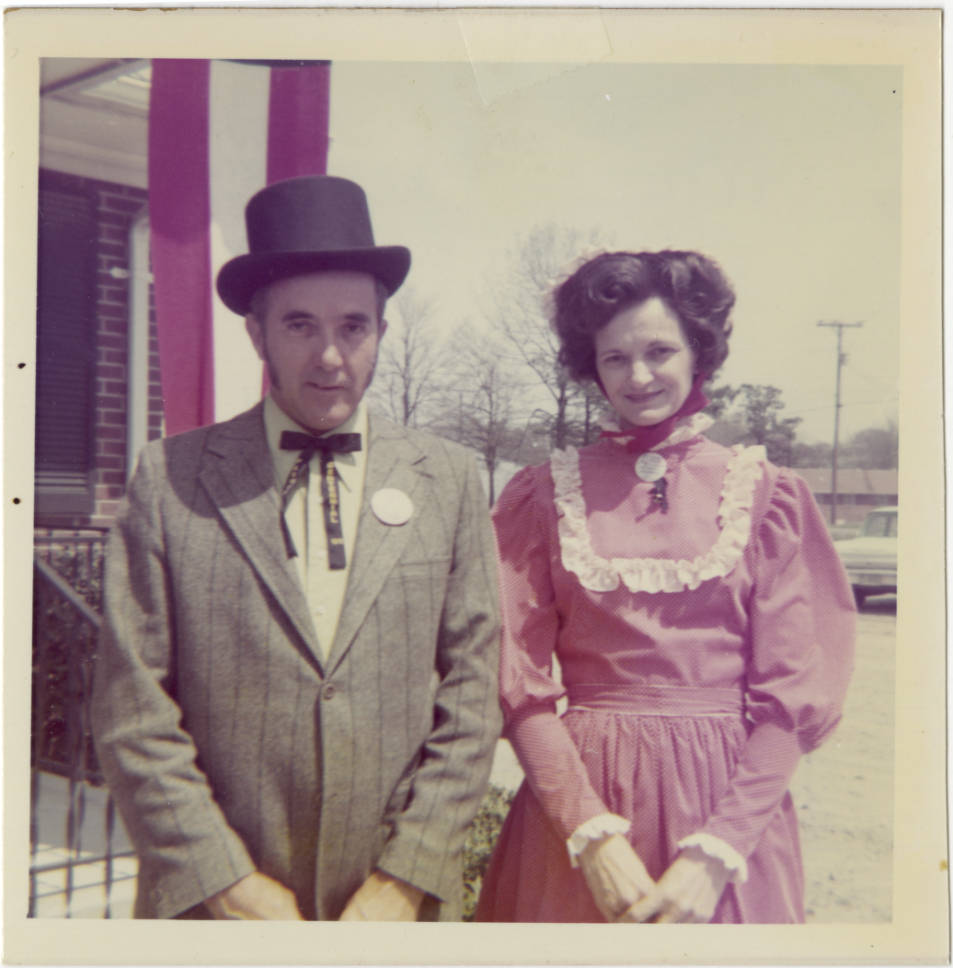
Farmville residents Mark Mozingo and Lottie Mozingo, 1972
In addition to North Carolina Memory, DigitalNC’s Images of North Carolina also contains photographs depicting Centennial Celebrations. The 1972 Farmville Centennial Celebration, for instance, has over 150 photographs documenting the centennial parade and the Farmville residents posing for portraits in period costume. Accompanying the photographs is Farmville’s 100th Anniversary book, which contains a detailed history of the town’s founding as well as accounts of notable residents, organizations, and events.
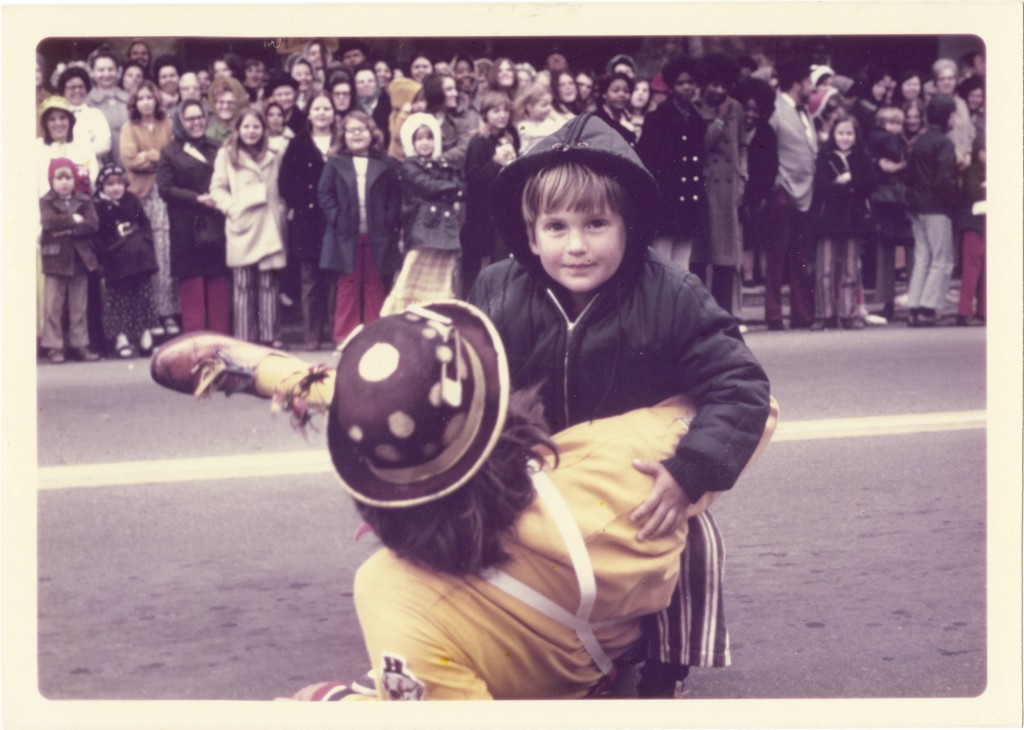
Child Posing with Clown on Main Street, Farmville 1972 Centennial Celebration
You may browse other images from North Carolina centennial celebrations here.

Elon’s The Pendulum staff publishes their ACC picks in 1991.
As you scramble to fill out your brackets, we at the North Carolina Digital Heritage Center thought it would be fun to see how the ACC tournament has been discussed across the state throughout the years since the tournament started in the 1950s. While we all know the big names in the tournament who call North Carolina home, many of the state’s smaller institutions have had a lot to say on the tournament over the years as well, even if their own school or anyone from their town is not participating. A look through the newspapers we have in DigitalNC shows that North Carolina is truly basketball country, especially in March.
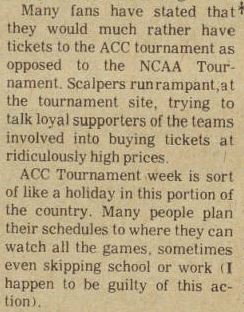
The columnist from the Clarion, Brevard’s student newspaper, in 1979 describing the tournament atmosphere in NC much as one finds it today.
The quote from the article above, from 1979, goes to show that the hyper-attention on the tournament is nothing new. Productivity in North Carolina during this week in March has always been rather low!
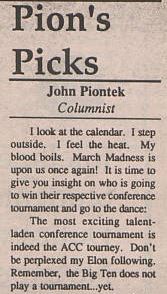
Elon’s student newspaper sports columnist in 1994 brushes off criticism for focusing on the ACC tournament by noting Elon doesn’t participate in any yet.
It seems that all the sports columnists in both town and other institution’s student newspapers had an opinion to offer on who they think will win the tournament that year and overall commentary on the tournament and how it stands up to others for the sport. Many of the columnists remark that having grown up in North Carolina they always followed the tournament, and so brush off any criticism over the fact their own school isn’t participating so why offer commentary?
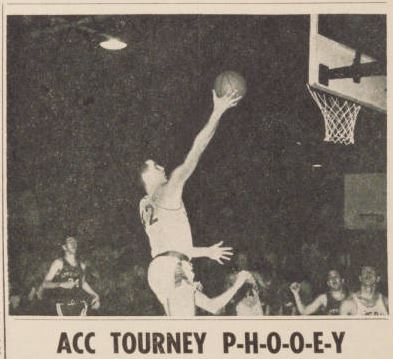
Headline for an article from Louisburg College’s “Columns” student newspaper in 1964, arguing the ACC tournament does not properly reward the best team in the ACC.
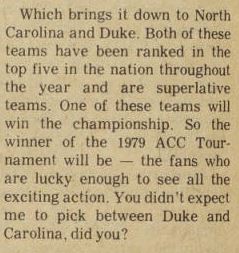
The other student newspapers across the state don’t tend to pick between the big blue rivalry. This is from the Clarion, Brevard College’s student newspaper, in 1979.
Duke and Carolina is the repeated rivalry throughout the sports columns discussing the tournament. There is even a column from Raeford’s The News-Journal that laments that North Carolina State University beat Duke in the first round of the tournament, noting that Duke was clearly the best team in the country.
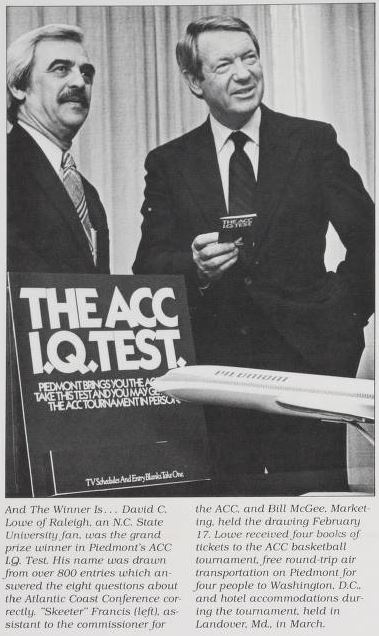
The airlines got in on the ACC fun too. This photograph from Piedmont Airlines’ company paper shows the winner of their ACC trivia contest, with a prize of roundtrip tickets to the tournament in 1981.
To view more ACC tournament news from the past and check out more North Carolina newspapers in general, visit the North Carolina Newspapers page. And as the NC Digital Heritage Center staff’s only bias is for all things North Carolina, we wish the Wolfpack, Deacons, Blue Devils, and Tar Heels well this week!
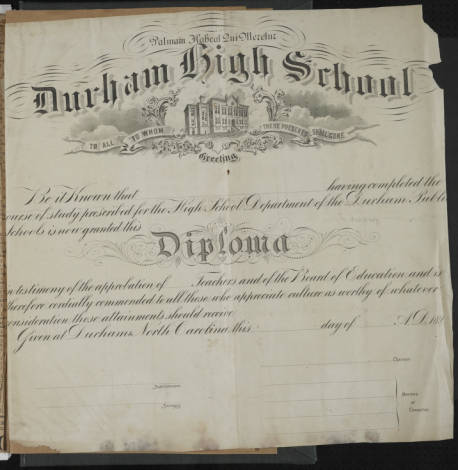 Clinton W. Toms (1868-1936) graduated from the University of North Carolina at Chapel Hill at the age of 21 and was a school principal prior to holding the position of superintendent for Durham schools from 1894 to 1897. Known as a progressive educator and philanthropist, he revamped the administration and arrangement of the graded school and helped to found the Durham Public Library in 1896. He introduced a compulsory manual training course to the curriculum and also reorganized the high school curriculum into subject departments. His efforts to secure funds to provide classroom materials brought him in contact with the Duke family. In 1897, he left the field of education to join the American Tobacco Company. This scrapbook documents Durham’s education system during Toms’ service as superintendent, primarily through newspaper clippings. Also included are school exercises, correspondence, and printed material.
Clinton W. Toms (1868-1936) graduated from the University of North Carolina at Chapel Hill at the age of 21 and was a school principal prior to holding the position of superintendent for Durham schools from 1894 to 1897. Known as a progressive educator and philanthropist, he revamped the administration and arrangement of the graded school and helped to found the Durham Public Library in 1896. He introduced a compulsory manual training course to the curriculum and also reorganized the high school curriculum into subject departments. His efforts to secure funds to provide classroom materials brought him in contact with the Duke family. In 1897, he left the field of education to join the American Tobacco Company. This scrapbook documents Durham’s education system during Toms’ service as superintendent, primarily through newspaper clippings. Also included are school exercises, correspondence, and printed material.
The Toms Scrapbook is shared online by the Durham County Library.
 Friday’s @ncdhc headline, from the Carolina Times, describes the arrest of two women on a Greyhound bus in Virginia in 1940: “Jim-Crow Bus Dispute Leads To Girls Arrest.” One of the women arrested was Pauli Murray.
Friday’s @ncdhc headline, from the Carolina Times, describes the arrest of two women on a Greyhound bus in Virginia in 1940: “Jim-Crow Bus Dispute Leads To Girls Arrest.” One of the women arrested was Pauli Murray.
Murray, who had lost a battle to enroll in the University of North Carolina in 1938, was living in New York at the time and was returning home to recover from an illness. She and Adelene McBean were arrested for their refusal to move to the back of the bus when asked by the driver. This was fourteen years before a similar incident in Montgomery, Alabama launched a nationwide movement, and just one of many occasions on which Pauli Murray fought against injustice.
Murray, described in the
Carolina Times article as a “honey-tongued legal mind,” was an author, lawyer, activist, and Episcopal priest who grew up in Durham. Her life and work is celebrated today by the
Pauli Murray Project at the Duke Human Rights Center.
 The “Unique Black Women” feature covers recognizable names, including journalist Ida B. Wells (1862-1931), activist Rosa Parks (1913-2005), and politician Shirley Chisholm (1924-2005). The editorial also celebrates local Durham heroes, such as West End neighborhood elder and activist Constance Walker (1942-).
The “Unique Black Women” feature covers recognizable names, including journalist Ida B. Wells (1862-1931), activist Rosa Parks (1913-2005), and politician Shirley Chisholm (1924-2005). The editorial also celebrates local Durham heroes, such as West End neighborhood elder and activist Constance Walker (1942-).






















 Clinton W. Toms (1868-1936) graduated from the University of North Carolina at Chapel Hill at the age of 21 and was a school principal prior to holding the position of superintendent for Durham schools from 1894 to 1897. Known as a progressive educator and philanthropist, he revamped the administration and arrangement of the graded school and helped to found the Durham Public Library in 1896. He introduced a compulsory manual training course to the curriculum and also reorganized the high school curriculum into subject departments. His efforts to secure funds to provide classroom materials brought him in contact with the Duke family. In 1897, he left the field of education to join the American Tobacco Company. This scrapbook documents Durham’s education system during Toms’ service as superintendent, primarily through newspaper clippings. Also included are school exercises, correspondence, and printed material.
Clinton W. Toms (1868-1936) graduated from the University of North Carolina at Chapel Hill at the age of 21 and was a school principal prior to holding the position of superintendent for Durham schools from 1894 to 1897. Known as a progressive educator and philanthropist, he revamped the administration and arrangement of the graded school and helped to found the Durham Public Library in 1896. He introduced a compulsory manual training course to the curriculum and also reorganized the high school curriculum into subject departments. His efforts to secure funds to provide classroom materials brought him in contact with the Duke family. In 1897, he left the field of education to join the American Tobacco Company. This scrapbook documents Durham’s education system during Toms’ service as superintendent, primarily through newspaper clippings. Also included are school exercises, correspondence, and printed material.
